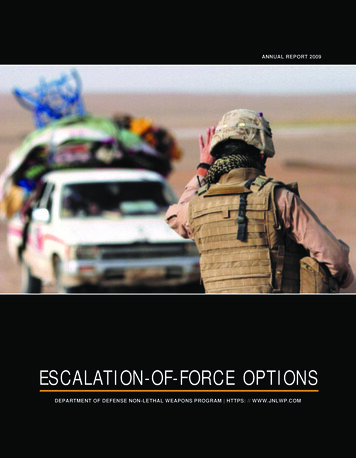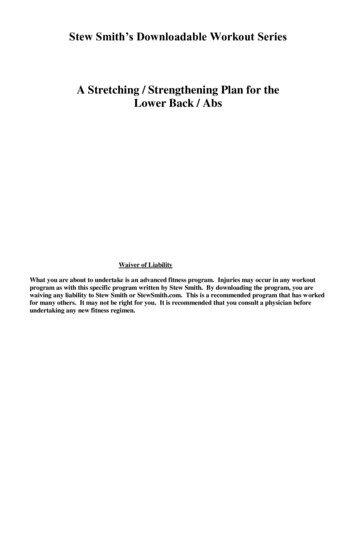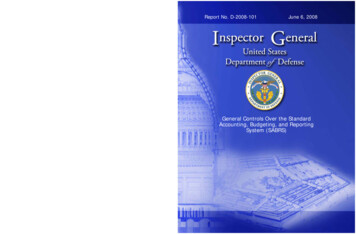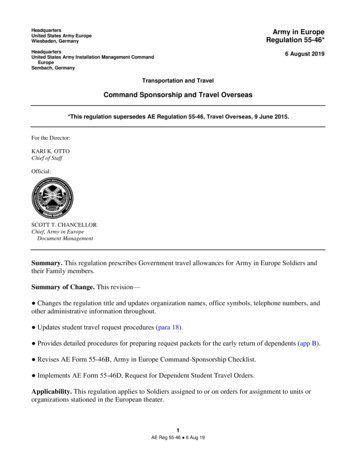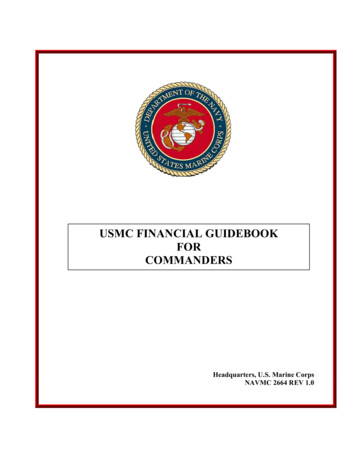
Transcription
USMC FINANCIAL GUIDEBOOKFORCOMMANDERSHeadquarters, U.S. Marine CorpsNAVMC 2664 REV 1.0
APR3 2009
NAVMC 2664LOCATOR SHEETSubj:USMC FINANCIAL GUIDEBOOK FOR COMMANDERSLocation:(Indicate location(s) of copy (ies) of this Manual.)ii
RECORD OF CHANGESPlease log completed change action as indicated.Change NumberDate of ChangeDate EnterediiiSignature of PersonIncorporated Change
CONTENTSPageI. USMC BUDGET1Introduction1Overview of the Planning, Programming, Budgeting and Execution (PPBE) Process1PPBE Process1Program Objective Memorandum (POM)1Budget Formulation2Mid-Year Review2Budget Execution2Money Flow2HQMC3Operating Budget (OPBUD)3Sub-Operating Budget (SUBOPBUD)3Allotments3Major Command Recipient Identifier (MRI)3Allotment Recipient Identifier (ARI)3Sub-Allotment Recipient Identifier (SRI)3Work Center Identifier (WCI)4Budget Execution Activities (BEA)4Budget Execution Sub-Activities (BESA)4Types of Appropriations4Marine Appropriations sometimes referred to as Green Appropriations4Military Personnel, Marine Corps (MPMC)4Reserve Personnel, Marine Corps (RPMC)4Operations and Maintenance, Marine Corps (O&MMC)5Operation and Maintenance, Marine Corps Reserve (O&MMCR)5Procurement, Marine Corps (PMC)5Procurement of Ammunition, Navy and Marine Corps (PANMC)5Navy Appropriations sometimes referred to as Blue AppropriationsNavy Working Capital Fund (NWCF)Nonappropriated Funds (NAF)556iv
II. COMMAND FINANCIAL MANAGEMENT7Overview7Commanders Financial Responsibility7Purpose Statue8Time (Bona Fide Need)8Amount (Antideficiency Act)8Expense/Investment Criteria9System Unit Cost10Central Management10Central Procurement10Command Budget Planning10Command Budget Execution11III. MARINE CORPS MANAGERS’ INTERNAL CONTROL PROGRAM (MCMIC) 12Introduction12Internal Controls Over Financial Reporting (ICOFR) Process12Overall Managers’ Internal Control (OMIC) Process13Managers’ Internal Control (MIC) Plan14Risk Assessments14Internal Control Assessment14Corrective Action Plan14Material Weakness Criteria14Managers’ Internal Control Program Statement of Assurance (SOA)15Audits, Inspections and Assistance Visits15Resource Evaluation and Analysis (REA)16Marine Corps Administrative Analysis Team (MCAAT)17Marine Corps Financial Evaluation and Analysis Team (MCFEAT)17Marine Corps Financial Management Operations Support (MCFMOS)17IV. CONTRACTING AND ACQUISITION18Contracting Supplies and Services18Contracting Activities18Contracting Authority Levels18v
Acquisition Cycle18Buying Goods and Services19Simplified Purchases19Micro-Purchases19Purchase Orders19Blanket Purchase Agreement (BPA)19PR Builder19Command Priorities19Contract Regulations / Guidance20Warfighting Requirements20V. FREQUENTLY ASKED QUESTIONS (FAQs)Basic Questions2222What are my financial duties and responsibilities?22What should my fiscal Marines be doing to support our fiscal mission?22What are the limits on my financial authority?22What are my execution goals?23What are my dollar value limits on execution?23What is an unauthorized commitment?23What is my contracting authority?24What is MyPay?24How are my civilians paid?25Mission Accomplishment25How do I request funds?25What can we spend during a Continuing Resolution Authority (CRA) period?26How should we ‘manage’ unfunded requirements?26Why are Unliquidated Obligations (ULO) important?26Why are Outstanding Travel Orders (OTO) important?27Why are Outstanding Travel Advances (OTA) important?27Why are outstanding commitments important?27Why are Unmatched Disbursements (UMD) important?27Why are Negative Unliquidated Obligations (NULO’s) important?28vi
How can I get outside assistance for Financial Management?28Appropriations / Authorization Funding28What are expiring funds?28When can funding execution cross fiscal years?28What are my limits on Official Representation Funds (ORFs)?29Procedurals DOs and DON’Ts30How does USMC fund contingency operations?30Why do I need to do a reimbursables?30How do we pay for other DoD Service / Agency support?30How do we pay for assisted acquisitions outside DoD?31What is the Government Travel Charge Card Program (GTCCP)?31What is the Government-wide Commercial Purchase Card (GCPC)?31Can I buy command medallions (coins)?32How do I fund conferences?33How do we buy computers, IT equipment?33What can I do to pay for the annual Marine Corps Birthday Ball?34Can I split one large purchase into smaller purchase with the GCPC?35Can I buy business cards?35Can I purchasing liberty attire for Marines in foreign destinations?35My Marines are in the field, can I use O&M funds to purchase water?35Can I use my O&M to provide coffee and donuts for my official meetings?36Can I use APF to pay for a fine that a Marine received while on official duty?36Can I use the Unit GCPC to place a deposit for a good or service?36What is a Business Process Improvement (BPI)?36VI. APPENDICES37A. Acronym Glossary37B. USMC Financial Management Marine Corps Orders41C. Useful Web Links42D. Other Suggested Links43vii
CHAPTER IUSMC BUDGETINTRODUCTIONFinancial Management is inherent in command. Your job is to ensure fundsentrusted to you are legally and judiciously spent.Since the onset of Operation Iraqi Freedom, annual Emergency Supplemental spendingbills to finance the costs of operations in Iraq and Afghanistan, as well as training, pre- and postdeployment, and equipment reset/reconstitution costs have provided a significant increase to theMarine Corps Total Obligation Authority (TOA). However, with Supplemental costs expectedto migrate to the Marine Corps baseline in Fiscal Year (FY) 2010 and competing federalspending priorities putting pressure on future year Department of Defense (DoD) budgets,Commanders must ensure they are able to effectively articulate requirements and placeconstrained resources where they will best accomplish unit missions and objectives.OVERVIEW OF THE PPBE PROCESSThe Planning Programming Budgeting and Execution (PPBE) Process serves as themeans for allocating resources and is a continuous overlapping cycle. Deputy Commandant,Programs and Resources (DC P&R), in concert with the other Deputy Commandants (DC),formulates the Marine Corps planning guidance which in turn supports the planning guidancedirected by the President of the United States (POTUS), Joint Chiefs of Staff (JCS), and theSecretary of Defense (SECDEF). The Commandant’s Planning Guidance (CPG) and the MarineCorps Master Plan (MCMP) serve as the base documents for building your program and yourbudget. For Battalion level commands, your supply officer will work in concert with theComptroller on the various budget calls. These documents can be provided to you by yourservicing Comptroller. As a Commander, the following major PPBE cycles impact you.The Program Objective Memorandum (POM) operates as a means for the Marine Corpsto “right-size” requirements and programs. It translates into a 6 year Defense Program. ThePOM occurs during even years. For example, POM 12 will be conducted in FY 2010. Duringodd years, a program review will occur. This review allows Commanders to tweak the workaccomplished during the POM. As a Commander, your role in the POM process is relativelystraightforward; every two years articulate what you can do within constraints of POM funding,or ceiling tracks, and what you can’t do with the funding you don’t get. Requirements should beprioritized as Mission Critical, Mission Essential, or Mission Enhancement, and include urgentemerging requirements. POM submissions and request for funds should include tangible,defensible metrics, not generalities or unsubstantiated dire predictions.Do not use the POM as a time to identify one time requirements; rather use it as a time toidentify programmatic changes. A Base Operations Support increase due to migration of NavyF-18 squadrons, Reserve Squadrons, and other service squadrons to Cherry Point in the futureprovides an example of a programmatic increase that will require future year funding. Loss ofthe Riverine Operations mission provides an example of a programmatic decrease in futureyears. A requirement for 1K to replenish lost SL3 components or 150K to install an elevator1
in a building do not constitute POM initiatives; rather, they are simply current year budgetshortfalls which should be addressed during year of execution either through the existing budgetor through a mid year review. It is a Commander’s responsibility to identify programmaticchanges that both increase and decrease funding requirements.The Deputy Commandants and the heads of the special staff agencies oversee the POMprocess within their sponsorship areas. The Programs and Resources (P&R) Department is theprincipal staff agency responsible for developing and defending the Marine Corps financialrequirements, policies, and programs. The DC P&R owns the Marine Corps resource allocationprocess and serves as the principal adviser to the Commandant on all financial matters.P&R provides budgetary guidance and appropriation ceilings to the MARFOR levelcommands. The MARFORs then provide their subordinate Commanders with this guidancecoupled with MARFOR specific guidance. Commanders should coordinate with their nexthigher level when preparing their POM submission.Budget Formulation serves to provide Commanders with a tool to prioritize theirrequirements and identify deficiencies to higher headquarters. The budget has its roots in thePOM development. At the HQMC level, the budget submitted to the President is a 2 year plan;however, for all commands below the CMC level, the budget numbers should be provided byyour Comptroller after each budget cycle (in June for the NAVCOMPT budget, in October forthe OSD budget, and in January for the President’s budget). Typically, the budget you receive inJune reflects planning documents spreading your budget among your subordinate commands.This June budget also serves as an opportunity to identify shortfalls. You need to provide detailsand justification and then prioritize these shortfalls based on the guidance provided to you byyour Comptroller. Budget Adjustments will be made once the appropriation bill is signed intolaw. Various changes will be assessed that might impact the numbers you previously received.In order for HQMC to answer budget questions, Commander’s need to articulate what thebudget buys. Many of the Congressional cuts the Marine Corps receives are because of aninability to explain why we spent the money the way we did. The ability to articulate why wespend our money on a requirement that is coded for both Global War on Terror (GWOT) use andGarrison use, such as contracted support, serves as a good example. HQMC cannot articulatethe “whys” to Congress without the assistance of Commanders.Mid Year Review typically starts in the Spring and offers a Commander an opportunity toreassess their requirements during year of execution. At this time, Commanders should reassesspriorities and submit any shortfalls up the chain of command.Budget Execution is continuous. Most Commanders will receive the preponderance oftheir funds from the Operation and Maintenance appropriation – a one year appropriation.During the year of execution, a Commander will execute his budget based on the plan heprepared. The critical aspects of this job will comprise the remainder of this manual.MONEY FLOWThe funds distribution process reflected within the accounting system begins with HQMC(P&R) issuing operating budgets or allotments to Commanders. Funding flows down the chainof command to the operating forces. Legal responsibility is passed down the chain of commandwith the flow of funds. This is referred to as “1517 responsibility.” Title 31 United State Code2
Section 1517 (31 U.S.C. 1517) makes obligating or expending in excess of the apportionment orreapportionment a crime. Commanders are ultimately responsible for funds as they movedown the chain of commandIn the absence of an annual Defense spending bill appropriated by Congress and signedinto law by the president, the Marine Corps may start the fiscal year under a ContinuingResolution Authority (CRA). A CRA allows Commanders the latitude to continue normaloperations and maintenance until a Defense spending bill is passed; however, no new initiativesor “new starts” may be executed. An example of a new start would be a large contract that hadnot previously been in place.The funds flow hierarchy is as follows: HQMC. HQMC issues operating budgets (OPBUD’s) and allotments which providefunding authority from a specific appropriation to a command to accomplish itsmission. OPBUD/allotment authority is expressed in terms of a specific amountgranted to incur obligations and payments in support of assigned missions andfunctions.o OPBUD/ Sub-Operating Budget (SUBOPBUD). An OPBUD is the annualbudget of an activity (responsibility center) stated in terms of functional/subfunctional categories and cost accounts. It contains estimates of the total valueof all resources required for mission performance of an activity, includingreimbursable work and/or services for others. OPBUDs are issued by HQMC toall responsibility centers. SUBOPBUDs are issued by designated responsibilitycenters to certain subordinate commands.o Allotments. The authority, expressed in terms of a specific amount of fundsgranted to a Commander by the Commandant, to obligate and expend funds for aparticular purpose. Obligation and expenditure of the funds may not exceed theamount specified in the allotment, and a command must adhere to the purposefor which the authorization is made. Major Command Recipient Identifier (MRI). A Major Command Recipient is acommand that receives funds directly from HQMC. Major Command Recipients maypass funds to Allotment Recipients within their command. Commander, U.S. MarineCorps Forces Pacific; Commander, U.S. Marine Corps Forces Command;Commander, Marine Corps Logistics Command; and Commander, Marine CorpsCombat Development Command are examples of Major Command Recipients. Allotment Recipient Identifier (ARI). An ARI is a command that receives anallotment or OPBUD from a MRI. Commander, Marine Corps Installations East andCommander, Marine Corps Installations West are examples of ARIs. MRIs are alsoARIs when they pass funds to themselves. An example of a MRI that passes funds tothemselves as an ARI is Commander, Marine Corps Forces Pacific. Suballotment Recipient Identifier (SRI). A SRI is a subordinate command thatreceives a portion of an allotment or OPBUD from an ARI. Examples of SRIs areMarine Corps Air Station Miramar, Marine Corps Base Camp Pendleton, and IMarine Expeditionary Force (MEF). Major Command Recipients are also3
Allotment/Suballotment Recipients when they pass funds to themselves. SRI is thelowest level at which legal responsibility (31 U.S.C. 1517 authority) can be passed. Work Center Identifier (WCI). A Work Center is a subdivision of a SRI. Theseactivities are held administratively responsible. Budget Execution Activity (BEA). A BEA is a subdivision of a Work Center. Legalresponsibility for the proper management of the funds is retained by the SRI or WCIholder. An example of a BEA is the facilities department within a base or a battalionwithin the MLG, DIV, or MAW. Budget Execution Sub-Activity (BESA). A BESA is a subdivision of a BEA. ABESA is established to capture detailed costs below the BEA and are the lowestorganizational level to which funding is broken down in the Marine Corps. BESAsfor all O&MMC funded activities have been standardized and are listed by applicableWCI in the standalone Financial Code Manual referenced in Appendix B.TYPES OF APPROPRIATIONAppropriations exist to exert control over government costs. Different appropriationsexist in order to finance differing types of requirements. Using one appropriation to financerequirements properly financed in another appropriation is a violation of the “Purpose Statute”and could lead to a violation of the “Antideficiency Act”The Marine Corps receives six appropriations. Four are annual appropriations (MilitaryPersonnel Active and Reserve, and Operations and Maintenance Active and Reserve), and twoare multi-year procurement appropriations (Procurement, Marine Corps and ProcurementAmmunition, Navy and Marine Corps). The Marine Corps has access to Nonappropriated fundsources and Navy Working Capital funds. The Marine Corps also uses funds appropriated to theNavy and DoD.An overview of major appropriations is below:Marine Appropriations sometimes referred to as Green Appropriations are controlled directlyby the Marine Corps. This funding is used to pay Marines, procure equipment, pay for training,buy food, fuel and spare parts, maintain military buildings, pay civilian salaries, and supportquality of life requirements such as community services. Military Personnel, Marine Corps (MPMC) – This annual appropriation impacts allActive Duty Marines. It provides for military pay, allowances, clothing, subsistence, andpermanent change of station moves. This is the largest appropriation received by theMarine Corps and is HQMC centrally administered by HQMC. (Note: the Marine CorpsJunior ROTC program is funded with O&MMC, and associated clothing is funded withMPMC.) Reserve Personnel, Marine Corps (RPMC) – This annual appropriation provides for pay,allowances, clothing, per diem, travel, and other related costs for Reserve Marine CorpsPersonnel, including Reserve officer candidates, and Reserve officers assigned to activeduty under 10 U.S.C. 265. HQMC centrally administers some of this appropriation butprovides select commands with the ability to execute transactions in support of annual4
training duty travel and per diem, and that portion dealing with clothing which, forcontrol purposes, is given out in specific amounts to designated responsibility centers. Operations and Maintenance, Marine Corps (O&MMC) – This annual appropriationprovides the funds to finance the costs of Marine Corps operations and maintenance.This appropriation serves as the primary source of funds to operating forces andinstallation commanders. Commanders use these funds to purchase supplies from theNavy Working Capital Fund, utilities, civilian labor, open market purchases, andtemporary additional duty, just to name a few. O&MMC is also a source of MarineCorps Community Services (MCCS) appropriated funds. This appropriated fund (APF)support is provided via the Uniform Funding and Management (UFM) procedures formorale, welfare and recreation (MWR) programs (discussed in the Nonappropriated Fund(NAF) section). MCCS also relies on NAF and OSD financial support for key DoD-widefamily and Marine support programs. Operation and Maintenance, Marine Corps Reserve (O&MMCR) – This annualappropriation supports the day-to-day operation of Reserve programs. Procurement, Marine Corps (PMC) – This three-year appropriation finances the purchaseof weapons, tracked combat vehicles, guided missiles and equipment, communicationsand electronic equipment, support vehicles, engineer and other support equipment, sparesand repair parts. Procurement of Ammunition, Navy and Marine Corps (PANMC) – This three-yearappropriation finances the purchase of ammunition and related items.Navy Appropriations sometimes referred to as Blue Appropriations represent the directsupport portions of the Navy’s budget spent on the Marine Corps that are in addition to MarineCorps "green dollar" appropriations. Blue dollars pay to procure, operate and maintain MarineCorps aircraft, provide Navy Corpsman and Chaplains, and other direct support items notcovered by green appropriations. These specific “Blue” dollar support efforts for the MarineCorps are often called “Blue in Support of Green” (BISOG). Other Navy support to the MarineCorps includes the cost of Navy personnel serving in Marine Corps organizations (MilitaryPersonnel, Navy); aircraft purchased for the Marine Corps inventory (Aircraft Procurement,Navy); aircraft fuel and maintenance, specifically authorized aviation-related materials andsupplies (O&M, Navy); equipment purchased by Marine Aviation units (Other Procurement,Navy); development costs for Marine Corps equipment and other programs (Research,Development, Test and Evaluation, Navy (RDT&E,N)); and Marine Corps requirements for newmilitary construction projects (Military Construction, Navy (MILCON), Military Construction,Naval Reserves (MCNR), and Family Housing, Navy and Marine Corps (FHN&MC)). Thereare many other areas of Navy support which are less visible, such as that portion of the cost ofthe Navy's air training command that goes to support the Marine Corps, and the funding ofvarious civilian training programs.Navy Working Capital Fund (NWCF) acts as a self-sufficient operation with funds generatedthrough the sale of goods and services to customers to replenish the costs of goods and servicessold. Costs of goods and services to customers incorporate all administrative, overhead, labor,and materials costs and these charges are passed with a small surcharge to the customer. Thefunds received by the NWCF from the operating forces for goods and services sold become thesource of funds used to finance future operations. Supply operations of NWCF provide for5
standard items of material, subsistence, petroleum, oil, lubricants, maintenance parts andassemblies, and minor items of equipment of a consumable nature where there is a recurringdemand. NWCF funds are not annually appropriated, but work off a revolving fund concept. Anexample of a NWCF funded activity is the Depot Maintenance Activity (DMA) at Albany, GA.Nonappropriated Funds (NAF) are government funds other than those appropriated by theCongress. The funds are generated by NAF Instrumentalities (NAFIs) authorized by competentauthority for the morale, welfare, comfort and/or recreation of military personnel or civilianemployees. Command level NAF retail, food/hospitality, billeting, and recreation outletsgenerate proceeds from operations used to supplement appropriated funds in providing MWRprograms and facilities. All Marine Corps NAF activities are instrumentalities of the U.S.Government and as such are entitled to all the immunities and privileges available togovernmental agencies. Despite the fact that these funds are generated by internal Marine Corpsactivities and not appropriated by Congress, they are government funds, and are subject to strictlegal rules. Since NAF activities are an integral part of base and station operations, they meritappropriated fund support based upon the level authorized for each category of NAFI. APFsupport is provided to a NAF activity via a Memorandum of Agreement (MOA) in accordancewith the Uniform Funding and Management (UFM) guidance provided by the AssistantSecretary of the Navy (Financial Management and Comptroller) (ASN (FM&C)) memo of 12October 2004 and DoD Instruction 1015.15.As a Commander, you will receive NAF funds from your MCCS representative tosupport morale and welfare functions for the Marines under your charge. These funds arereferred to as Unit and Family Readiness Funds (U&FRF). U&FRF (incorporating the formerpicnic and party funds) are intended to support unit MWR needs including recreational, social,and family readiness activities. In an effort to make U&FRF simple and easy to use forCommanders, MCCS has taken action to establish a single NAF allocation per Marine per year,for units home-based at Marine Corps installations. This also applies to sailors or other servicemembers assigned to the unit and in support of Marines. The funds are to be used in the yearprovided rather than accumulated over time. These funds shall not be carried over at NAF fiscalyear-end (31 January). Funds will be allocated quarterly based on the onboard unit end strengthfor the command, as reported in Marine Corps Total Force System (MCTFS). More informationabout NAF funds can be obtained from MCO P1700.27B and your MCCS representative.6
CHAPTER IICOMMAND FINANCIAL MANAGEMENTOVERVIEWThe majority of funds allocated to the Marine Corps in the federal budget are committedto pay for ‘fixed costs’ and are not available for reprogramming to meet emergent ordiscretionary requirements. The Marine Corps manpower appropriation, for example, comprises56.8% of the total USMC budget and is “fenced” to “buy” Marines. The actual discretionaryfunds that are available to each USMC Commander are therefore quite limited.Major USMC AppropriationsFY08 22.8B(includes 202K increase)Operating Forces & Support 1.9B (8.5%)Day to Day Operating CostsMajor ExercisesDepot MaintenanceO&MMCInvestment 4.6B (20.2%)Warfighting InvestmentAmmunitionRDT&EPMCManpower 12.9B (56.8%)Military PayDefense HealthO&MInfrastructure 3.3B (14.5%)Military ConstructionFacilities SustainmentFacilities Restoration and ModernizationFamily HousingCOMMANDER’S FINANCIAL RESPONSIBILITYThe Antideficiency Act (ADA) consists of a series of federal statutes that make it illegalfor government officials to spend money other than as Congress intends. If violated, the ADArequires a formal investigation process with the results reported to Congress. Violations can leadto adverse personnel actions and even criminal proceedings. There are three primary legalconsiderations affecting the Commander's responsibility with funds entrusted to him. The first isthe "Purpose Statute” (31 U.S.C. 1301); the second legal consideration deals with the timemoney is available to spend (31 U.S.C. 1502); and the third legal consideration deals withamounts available to spend (31 U.S.C. 1517).7
Purpose – An all-too-common pitfall for Commanders centers on violating the “Color ofMoney” or the “Purpose Statute,” 31 U.S.C. 1341. This represents a legal violation and isrequired to be reported to the President via the Office of Management and Budget (OMB),Congress, and the Government Accountability Office (GAO). Disciplinary action taken must bespelled out in the letter. Congress appropriates funds to the Marine Corps for specific purposes,with the expectation that those funds will only be used for those purposes. Exceeding the minorconstruction threshold or using O&M to purchase centrally managed equipment (such asvehicles) that should have been purchased by Marine Corps Systems Command (MCSC) withPMC represent the most common Purpose Statute violations committed by Marine CorpsCommanders.The necessary expense doctrine falls under the purpose statute. It states that agenciesmay only spend appropriated funds for a necessary expense of the programs it is operating. Inother words, appropriations, “shall be applied only to the objects for which the appropriationswere made except as otherwise provided by law.” The Comptroller General has issued manyopinions indicating that expenditures for personal items, such as 400 watches or engraved Kbars, generally do not qualify as a necessary expense. Low cost items classified as personal giftsare not necessary expenses and may not be purchased with appropriated funds unless there isspecific statutory authority to do so. Commanders are advised to coordinate with both theirComptroller and their local Area Counsel Office when questions arise. A three part necessaryexpense analysis applies: First, verify the expenditure is ‘necessary’ to accomplish the object of an appropriation,or will contribute materially to the accomplishment of that objective.Second, assess that the expenditure is not prohibited by law. This is done by reviewingthe legislation for prohibitive language and restrictions.Third, determine if the expenditure is otherwise provided for. If there are two or moreappropriations available for the expenditure, use the most specific appropriation.Time – Congress grants funding for specific time periods and funds must be obligatedduring that period. Not only must money be obligated during its period of availability, butobligations must be a "Bona Fide Need" of that period. This rule mandates that money only beobligated to meet a legitimate or bona fide need arising in the fiscal year for which theappropriation was made. It restricts this year’s appropriated funds from being used to fund nextfiscal year’s requirements. Purchasing items with annual funds appropriated for FY 2009 thatwill be stock piled and used in FYs 2010, 2011, and 2012 is a violation of the intent of Congressand is an ADA violation. Contracts may legally be entered into during one fiscal year and crossover into the next fiscal year. Examples include severable and non-severable contracts.Severable contracts can be separated into components that independently meet a separateneed of the government. Examples of severable service contracts include admin support,housekeeping services, and trash collection. Statutory authority exists that allows servicecontracts (and leases) to cross fiscal years. This is so an agency can space out their contracts andnot have to start all contracts in October. These contracts can not exceed 12 months in duration.Non-severable contracts produce a single outcome, product, or report that cannot besubdivided for separate performance. Examples include: overhaul of a ship, development of asoftware program, or an effort that will result in a end product. Training tends to be non8
severable. In non-severable service contracts, the government must fund the entire effort withdollars available for obligation at the time the contract is executed. The contract performancemay cross fiscal years and the period of performance may exceed 12 months.Amount – Amount represents the final fiscal law principle. The bottom line is that youare not allowed to spend more than allotted to your command. This can be avoided by matchingyour annual budget to requirements, identifying and forwarding deficiencies for review and anyadditional funds that may become available, and periodically matching what funds you haveremaining with the requirements you have pending. Rely on your Comptroller and rememberearly
Apr 03, 2009 · USMC BUDGET INTRODUCTION Financial Management is inherent in command. Your job is to ensure funds entrusted to you are legally and judiciously spent. Since the onset of Operation Iraqi Freedom, annual Emergency Supplemental spending bills to finance the costs of operations in
